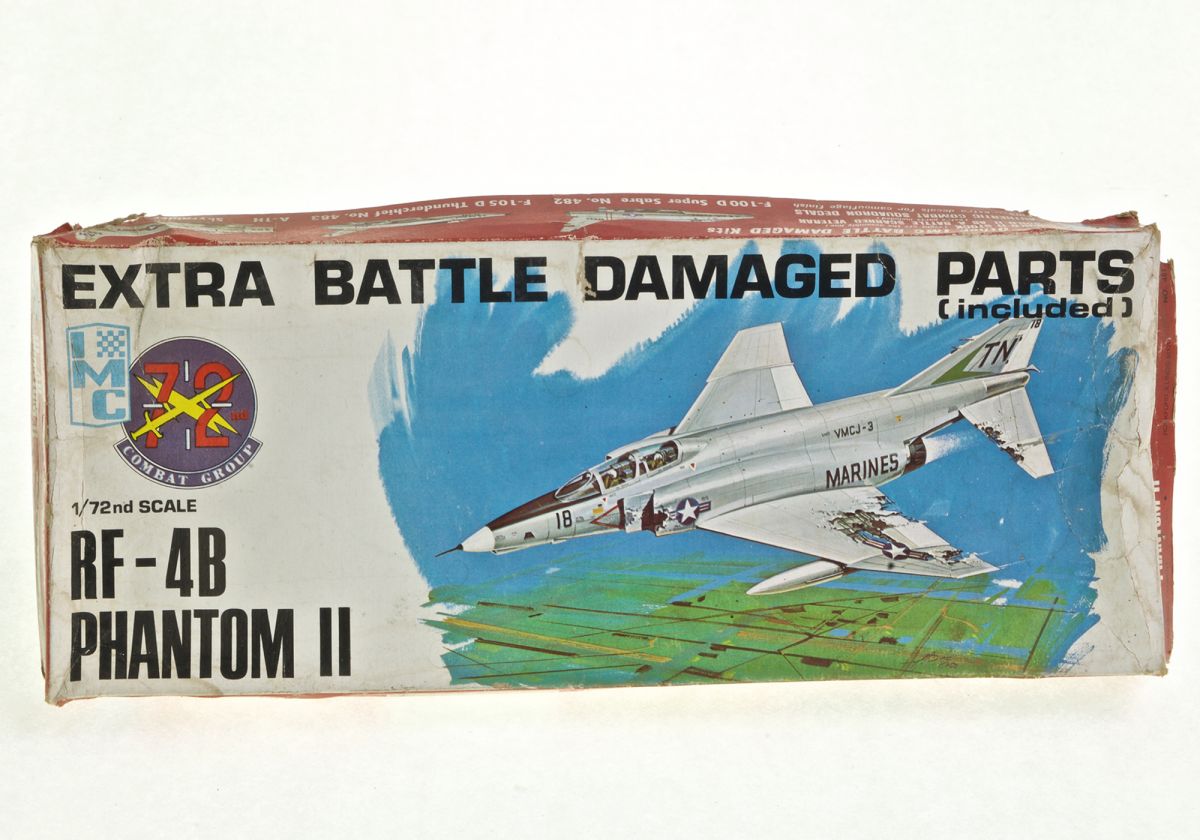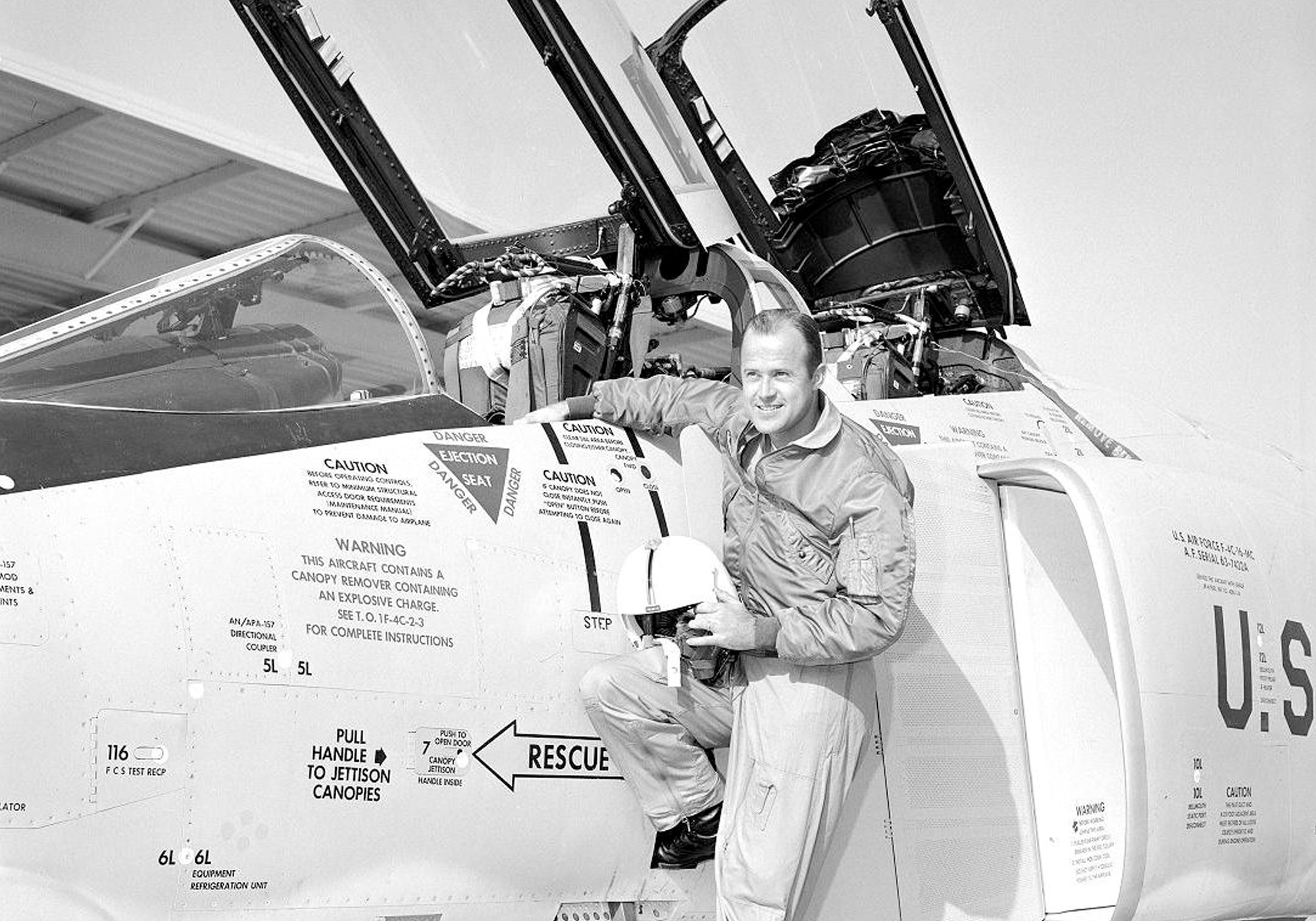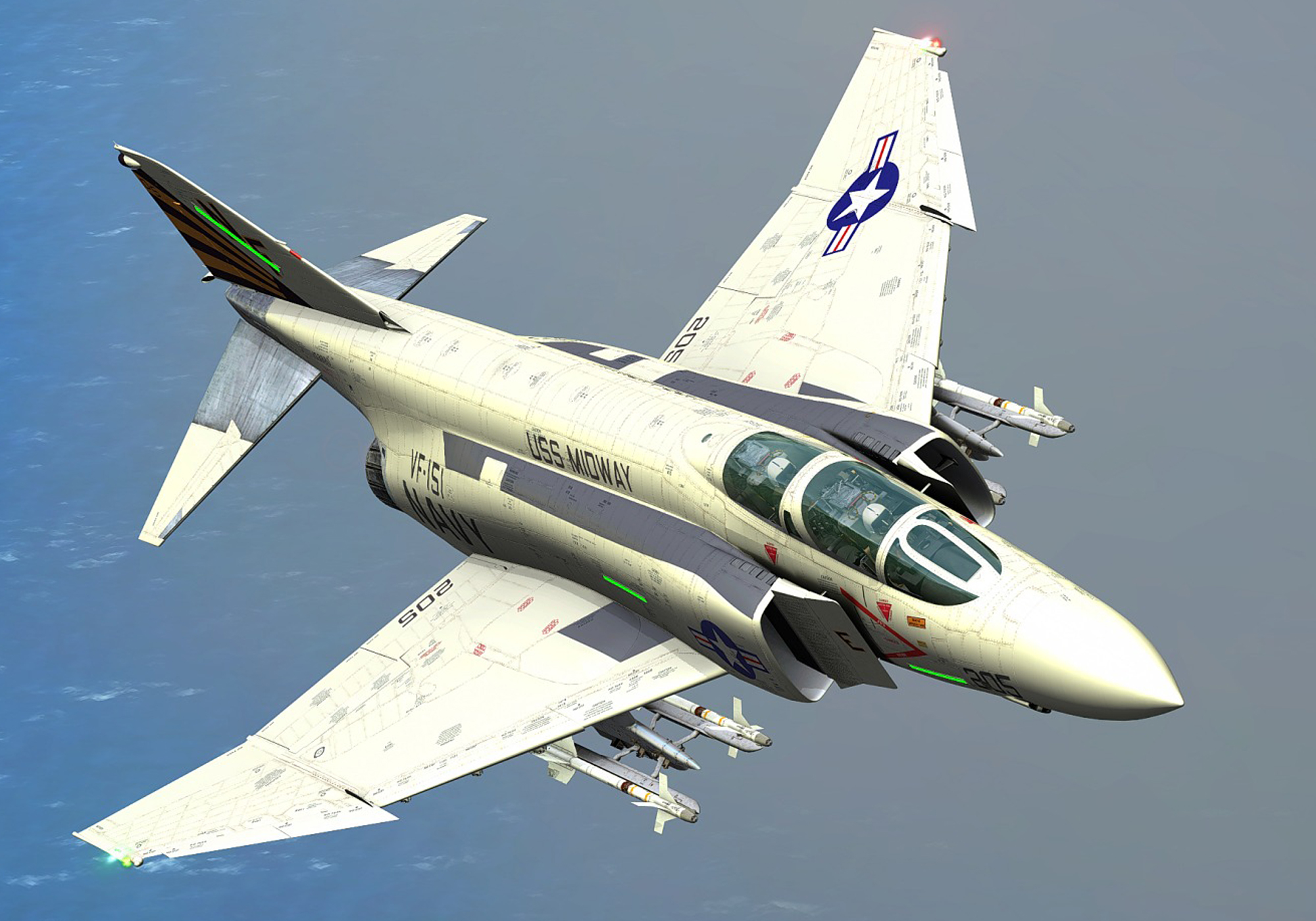- AUST POST SHIPPING
- 0438 654 235
- info@recoverycurios.com
- P.O. Box 7640 Cairns QLD Australia, 4870
-
0
Shopping Cart

RF-4B PHANTOM II - IMC 1/72 scale
The McDonnell Douglas F-4 Phantom II was a tandem two-seat, twin-engine, all-weather, long-range supersonic jet interceptor and fighter-bomber originally developed for the United States Navy by McDonnell Aircraft. It first entered service in 1960 with the U.S. Navy and proved to be so adaptable, it was also adopted by the U.S. Marine Corps and the U.S. Air Force, and by the mid-1960s had become a major part of their air wings.
The Phantom was a large fighter with a top speed of over Mach 2.2. It can carry more than 18,000 pounds of weapons on nine external hard-points, including air-to-air missiles, air-to-ground missiles, and various bombs. The F-4, like other interceptors of its time, was designed without an internal cannon. Later models incorporated an M61 Vulcan rotary cannon. Beginning in 1959, it set 15 world records for in-flight performance, including an absolute speed record, and an absolute altitude record.
The F-4 was used extensively during the Vietnam War. It served as the principal air superiority fighter for both the Navy and Air Force, and became important in the ground-attack and aerial reconnaissance roles late in the war. The Phantom has the distinction of being the last U.S. fighter flown by pilots who attained ace status in the 20th century. During the Vietnam War, one U.S. Air Force pilot and two weapon systems officers (WSOs), and one U.S. Navy pilot and one radar intercept officer (RIO) became aces by achieving five aerial kills against enemy fighter aircraft. The F-4 continued to form a major part of U.S. military air power throughout the 1970s and 1980s, being gradually replaced by more modern aircraft such as the F-15 Eagle and F-16 in the U.S. Air Force, the Grumman F-14 Tomcat in the U.S. Navy, and the F/A-18 Hornet in the U.S. Navy and U.S. Marine Corps.
In air combat, the Phantom's greatest advantage was its thrust, which permitted a skilled pilot to engage and disengage from the fight at will. As a massive fighter aircraft designed to fire radar-guided missiles from beyond visual range, it lacked the agility of its Soviet opponents and was subject to adverse yaw during hard manoeuvring. Although thus subject to irrecoverable spins during aileron rolls, pilots reported the aircraft to be very communicative and easy to fly on the edge of its performance envelope. In 1972, the F-4E model was upgraded with leading edge slats on the wing, greatly improving high angle of attack manoeuvrability at the expense of top speed.
The F-4's biggest weakness, as it was initially designed, was its lack of an internal cannon. For a brief period, doctrine held that turning combat would be impossible at supersonic speeds and little effort was made to teach pilots air combat manoeuvring. In reality, engagements quickly became subsonic, as pilots would slow down in an effort to get behind their adversaries. Furthermore, the relatively new heat-seeking and radar-guided missiles at the time were frequently reported as unreliable and pilots had to use multiple shots (also known as ripple-firing), just to hit one enemy fighter. To compound the problem, rules of engagement in Vietnam precluded long-range missile attacks in most instances, as visual identification was normally required. Many pilots found themselves on the tail of an enemy aircraft but too close to fire short-range Falcons or Sidewinders. Although by 1965 USAF F-4Cs began carrying SUU-16 external gun-pods containing a 20 mm M61A1 Vulcan Gatling cannon, USAF cockpits were not equipped with lead-computing gunsights until the introduction of the SUU-23, virtually assuring a miss in a manoeuvring fight. Some Marine Corps aircraft carried two pods for strafing. In addition to the loss of performance due to drag, combat showed the externally mounted cannon to be inaccurate unless frequently bore-sighted, yet far more cost-effective than missiles. The lack of a cannon was finally addressed by adding an internally mounted 20 mm M61A1 Vulcan on the F-4E.
On 10 May 1972, Lieutenant Randy "Duke" Cunningham and Lieutenant William P. Driscoll flying an F-4J, call sign "Showtime 100", shot down three MiG-17s to become the first American flying aces of the war. Their fifth victory was believed at the time to be over a mysterious North Vietnamese ace, Colonel Nguyen Toon, now considered mythical. On the return flight, the Phantom was damaged by an enemy surface-to-air missile. To avoid being captured, Cunningham and Driscoll flew their burning aircraft using only the rudder and afterburner (the damage to the aircraft rendered conventional control nearly impossible), until they could eject over water.
Unlike the U.S. Navy and U.S. Marine Corps, which flew the Phantom with a Naval Aviator (pilot) in the front seat and a Naval Flight Officer as a radar intercept officer (RIO) in the back seat, the USAF initially flew its Phantoms with a rated Air Force Pilot in front and back seats. While the rear pilot (GIB, or "guy in back") could fly and ostensibly land the aircraft, he had fewer flight instruments and a very restricted forward view. The Air Force later assigned a rated Air Force Navigator qualified as a weapon/targeting systems officer (later designated as weapon systems officer or WSO) in the rear seat instead of another pilot. However, all USAF Phantoms retained dual flight controls throughout their service life.
On 10 July 1965, F-4Cs of the 45th Tactical Fighter Squadron, 15th TFW, on temporary assignment in Ubon, Thailand, scored the USAF's first victories against North Vietnamese MiG-17s using AIM-9 Sidewinder air-to-air missiles. On 26 April 1966, an F-4C from the 480th Tactical Fighter Squadron scored the first aerial victory by a U.S. aircrew over a North Vietnamese MiG-21. On 24 July 1965, another Phantom from the 45th Tactical Fighter Squadron became the first American aircraft to be downed by an enemy SAM, and on 5 October 1966 an 8th Tactical Fighter Wing F-4C became the first U.S. jet lost to an air-to-air missile, fired by a MiG-21.
Although the F-4C was essentially identical to the Navy/Marine Corps F-4B in flight performance and carried the AIM-9 Sidewinder missiles, USAF-tailored F-4Ds initially arrived in June 1967 equipped with AIM-4 Falcons. However, the Falcon, like its predecessors, was designed to shoot down heavy bombers flying straight and level. Its reliability proved no better than others and its complex firing sequence and limited seeker-head cooling time made it virtually useless in combat against agile fighters. The F-4Ds reverted to using Sidewinders under the "Rivet Haste" program in early 1968, and by 1972 the AIM-7E-2 "Dogfight Sparrow" had become the preferred missile for USAF pilots. Like other Vietnam War Phantoms, the F-4Ds were urgently fitted with radar homing and warning (RHAW) antennas to detect the Soviet-built S-75 Dvina SAMs.
The F-4 Phantom II remained in use by the U.S. in the reconnaissance and Wild Weasel (Suppression of Enemy Air Defences) roles in the 1991 Gulf War, finally leaving service in 1996. It was also the only aircraft used by both U.S. flight demonstration teams: the USAF Thunderbirds (F-4E) and the US Navy Blue Angels (F-4J). The F-4 was also operated by the armed forces of 11 other nations. Israeli Phantoms saw extensive combat in several Arab–Israeli conflicts, while Iran used its large fleet of Phantoms acquired before the fall of the Shah in the Iran–Iraq War. Phantoms remain in frontline service with four countries. Phantom production ran from 1958 to 1981, with a total of 5,195 built, making it the most produced American supersonic military aircraft.
As of 2017, nearly 60 years after its introduction, the F-4 remains in service with Iran, Japan, South Korea, and Turkey. The aircraft has most recently seen service against the Islamic State group the Middle East.
The Phantom II model kit features option 'Battle damaged' components to simulate North Vientnamese SAM missle damage.
Whilst the box might reflect the vintage age of the kit, the actual kit itself comes complete with all components still sealed in their plastic wrapping along with all instructions and decals.
- LAND
- SEA
- AIR
- VINTAGE ORIGINAL AIRCRAFT INSTRUMENTS
- HAWKER TYPHOON
- VICKERS WELLINGTON
- FAIREY GANNET
- RYAN ST-A SPORTS TRAINER
- DE HAVILLAND TIGER MOTH
- HAWKER HUNTER
- Mc DONNELL DOUGLAS KC-10 AERIAL TANKER
- SOPWITH CAMEL
- AIRCO DH.1 AND DH.2
- JUNKERS JU 87
- CURTISS C-46 COMMANDO
- HANDLEY PAGE HAMPDEN
- SUPERMARINE SEAFIRE
- B-25 MITCHELL BOMBER
- BRISTOL BLENHEIM
- ENGLISH ELECTRIC LIGHTNING
- HAWKER TEMPEST MkVI
- YAKOVELOV YAK - 3
- FOCKE-WULF FW190
- FOLLAND GNAT
- AIRSPEED OXFORD
- SHORT STIRLING
- AVRO ANSON
- DOUGLAS C-133 CARGOMASTER
- HANDLEY PAGE VICTOR BOMBER
- DE HAVILLAND SEA VENOM
- VICKERS VALIANT BOMBER
- DOUGLAS A-26 INVADER
- GRUMMAN S2F TRACKER
- SUPERMARINE SPITFIRE
- LOCKHEED P2-V NEPTUNE
- P-51 MUSTANG
- BRISTOL BEAUFIGHTER
- DE HAVILLAND MOSQUITO
- B-26 MARTIN MARAUDER
- P3 ORION
- DOUGLAS A-20 HAVOC
- P-39 AIRACOBRA
- AVRO SHACKLETON
- B-17 FLYING FORTRESS
- B-24 LIBERATOR
- MESSERSCHMITT BF-110
- MESSERSCHMITT BF-109
- BRISTOL BEAUFORT
- KAWASAKI Ki-45 (NICK) INTERCEPTOR
- C-130 HERCULES
- CAC BOOMERANG
- AVRO LANCASTER
- GRUMMAN F4F WILDCAT
- F4U VOUGHT CORSAIR
- WESTLAND LYSANDER
- P-47 REPUBLIC THUNDERBOLT
- NORTH AMERICAN T-6 TEXAN - HAVARD
- C-47 SKYTRAIN
- DOUGLAS SBD DAUNTLESS
- CAC WIRRAWAY
- PBY CATALINA
- P-40 WARHAWK
- FAIREY SWORDFISH
- P-38 LIGHTNING
- HAWKER HURRICANE
- CURTISS SB2C HELLDIVER
- GRUMMAN F6F HELLCAT
- SEAKING HELICOPTER
- SEAHAWK HELICOPTER
- DOUGLAS A4G SKYHAWK
- GRUMMAN TBF AVENGER
- HANDLEY PAGE HALIFAX
- DOUGLAS SKYRAIDER AE-1
- GLOSTER METEOR
- JUNKERS JU-88
- F-86 SABRE JET
- SHORT SUNDERLAND
- B-29 SUPER FORTRESS
- F-9F GRUMMAN PANTHER
- F-100D SUPER SABRE
- BELL UH-1 HUEY HELICOPTER
- AVRO VULCAN STRATEGIC BOMBER
- CANBERRA BOMBER
- DHC-4 CARIBOU
- BLACKBURN BUCCANEER
- DE HAVILLAND VAMPIRE JET
- HAWKER SEA FURY
- LOCKHEED HUDSON
- LOCKHEED EC-121 WARNING STAR
- SEPECAT JAGUAR
- HAWKER SIDDELEY NIMROD
- HAWKER SIDDELEY HARRIER
- ARADO AR 196
- VOUGHT OS2U KINGFISHER
- LOCKHEED ELECTRA
- NORTHROP P-61 BLACK WIDOW
- BOEING CH-47 CHINOOK
- LOCKHEED PV-1 VENTURA
- BOEING P26-A 'PEASHOOTER'
- Ilyushin Il-2 ‘Sturmovik’
- WESTLAND WESSEX
- FAIREY FIREFLY
- VINTAGE AVIATION COLLECTABLES
- VINTAGE COLLECTABLE MODEL AIRCRAFT KITS
- RETRO STYLE METAL AIRCRAFT COLLECTABLES
- VINTAGE ORIGINAL AIRCRAFT INSTRUMENTS



